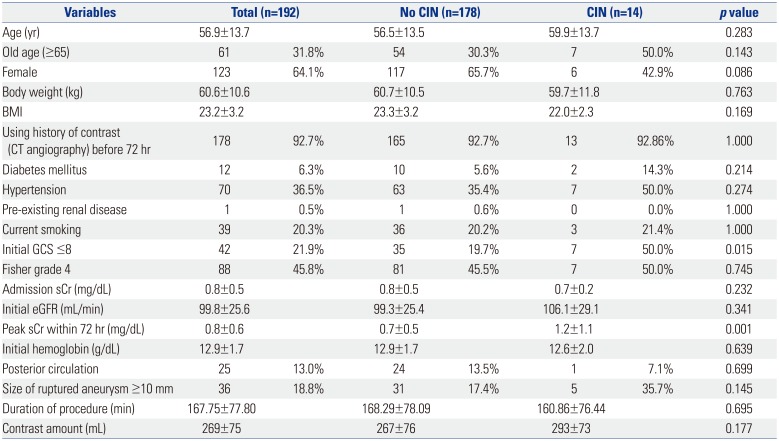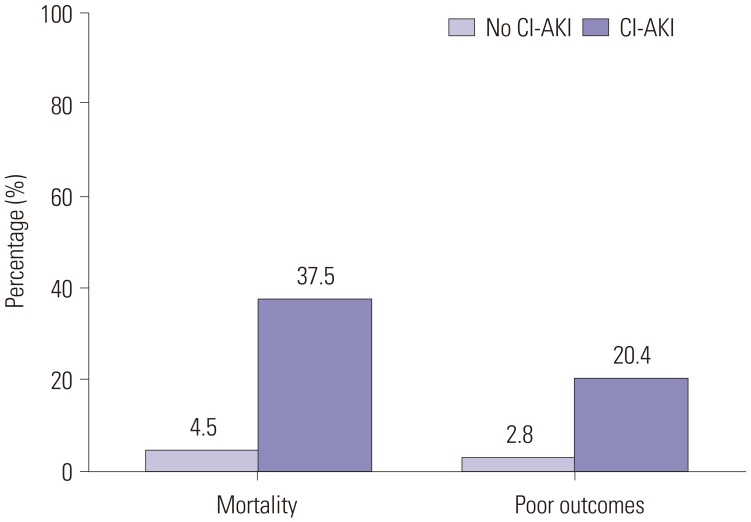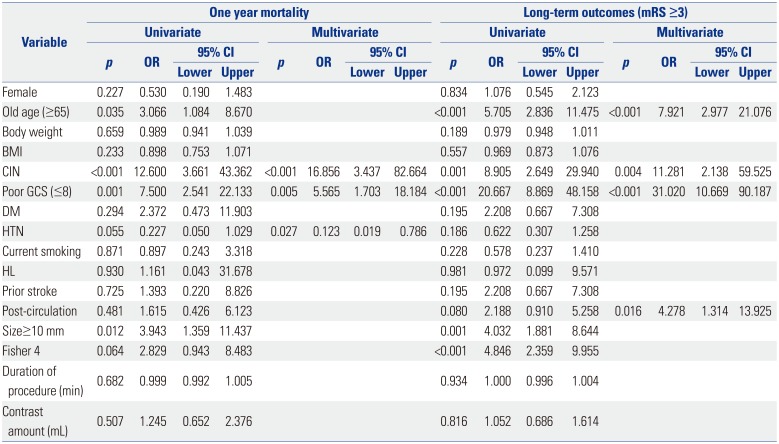1. Kim JH, Yang JH, Choi SH, Song YB, Hahn JY, Choi JH, et al. Predictors of outcomes of contrast-induced acute kidney injury after percutaneous coronary intervention in patients with chronic kidney disease. Am J Cardiol. 2014; 114:1830–1835. PMID:
25438909.

2. Pyxaras SA, Sinagra G, Mangiacapra F, Perkan A, Di Serafino L, Vitrella G, et al. Contrast-induced nephropathy in patients undergoing primary percutaneous coronary intervention without acute left ventricular ejection fraction impairment. Am J Cardiol. 2013; 111:684–688. PMID:
23261003.

3. Marenzi G, Lauri G, Assanelli E, Campodonico J, De Metrio M, Marana I, et al. Contrast-induced nephropathy in patients undergoing primary angioplasty for acute myocardial infarction. J Am Coll Cardiol. 2004; 44:1780–1785. PMID:
15519007.

4. Brown JR, Malenka DJ, DeVries JT, Robb JF, Jayne JE, Friedman BJ, et al. Transient and persistent renal dysfunction are predictors of survival after percutaneous coronary intervention: insights from the Dartmouth Dynamic Registry. Catheter Cardiovasc Interv. 2008; 72:347–354. PMID:
18729173.

5. Mason RA, Arbeit LA, Giron F. Renal dysfunction after arteriography. JAMA. 1985; 253:1001–1004. PMID:
3968822.

6. Solomon R, Dauerman HL. Contrast-induced acute kidney injury. Circulation. 2010; 122:2451–2455. PMID:
21135373.

7. Solomon RJ, Natarajan MK, Doucet S, Sharma SK, Staniloae CS, Katholi RE, et al. Cardiac Angiography in Renally Impaired Patients (CARE) study: a randomized double-blind trial of contrast-induced nephropathy in patients with chronic kidney disease. Circulation. 2007; 115:3189–3196. PMID:
17562951.
8. Prasad V, Gandhi D, Stokum C, Miller T, Jindal G. Incidence of contrast material-induced nephropathy after neuroendovascular procedures. Radiology. 2014; 273:853–858. PMID:
25102293.

9. Seeliger E, Sendeski M, Rihal CS, Persson PB. Contrast-induced kidney injury: mechanisms, risk factors, and prevention. Eur Heart J. 2012; 33:2007–2015. PMID:
22267241.

10. Brown JR, Robb JF, Block CA, Schoolwerth AC, Kaplan AV, O’Connor GT, et al. Does safe dosing of iodinated contrast prevent contrast-induced acute kidney injury? Circ Cardiovasc Interv. 2010; 3:346–350. PMID:
20587788.

11. Marenzi G, Assanelli E, Campodonico J, Lauri G, Marana I, De Metrio M, et al. Contrast volume during primary percutaneous coronary intervention and subsequent contrast-induced nephropathy and mortality. Ann Intern Med. 2009; 150:170–177. PMID:
19189906.

12. Teasdale G, Jennett B. Assessment of coma and impaired consciousness. A practical scale. Lancet. 1974; 2:81–84. PMID:
4136544.
13. Teasdale G, Jennett B. Assessment and prognosis of coma after head injury. Acta Neurochir (Wien). 1976; 34:45–55. PMID:
961490.

14. Alessandri N, Lanzi L, Garante CM, Tersigni F, Sergiacomi R, Petrassi M, et al. Prevention of acute renal failure post-contrast imaging in cardiology: a randomized study. Eur Rev Med Pharmacol Sci. 2013; 17(Suppl 1):13–21. PMID:
23436661.
15. Mehran R, Aymong ED, Nikolsky E, Lasic Z, Iakovou I, Fahy M, et al. A simple risk score for prediction of contrast-induced nephropathy after percutaneous coronary intervention: development and initial validation. J Am Coll Cardiol. 2004; 44:1393–1399. PMID:
15464318.
16. Rihal CS, Textor SC, Grill DE, Berger PB, Ting HH, Best PJ, et al. Incidence and prognostic importance of acute renal failure after percutaneous coronary intervention. Circulation. 2002; 105:2259–2264. PMID:
12010907.

17. Steiner T, Juvela S, Unterberg A, Jung C, Forsting M, Rinkel G, et al. European Stroke Organization guidelines for the management of intracranial aneurysms and subarachnoid haemorrhage. Cerebrovasc Dis. 2013; 35:93–112. PMID:
23406828.

18. Feigin VL, Rinkel GJ, Lawes CM, Algra A, Bennett DA, van Gijn J, et al. Risk factors for subarachnoid hemorrhage: an updated systematic review of epidemiological studies. Stroke. 2005; 36:2773–2780. PMID:
16282541.
19. Cayla G, Silvain J, Collet JP, Montalescot G. Updates and current recommendations for the management of patients with non-ST-elevation acute coronary syndromes: what it means for clinical practice. Am J Cardiol. 2015; 115:10A–22A.

20. Chavakula V, Gross BA, Frerichs KU, Du R. Contrast-induced nephropathy in patients with aneurysmal subarachnoid hemorrhage. Neurocrit Care. 2013; 19:157–160. PMID:
23839706.

21. Ray B, Rickert KL, Welch BG, White JA, Klinger DR, Boudreaux BP, et al. Development of contrast-induced nephropathy in subarachnoid hemorrhage: a single center perspective. Neurocrit Care. 2013; 19:150–156. PMID:
23653268.

22. Alexopoulos E, Spargias K, Kyrzopoulos S, Manginas A, Pavlides G, Voudris V, et al. Contrast-induced acute kidney injury in patients with renal dysfunction undergoing a coronary procedure and receiving non-ionic low-osmolar versus iso-osmolar contrast media. Am J Med Sci. 2010; 339:25–30. PMID:
19996728.

23. Connolly ES Jr, Rabinstein AA, Carhuapoma JR, Derdeyn CP, Dion J, Higashida RT, et al. Guidelines for the management of aneurysmal subarachnoid hemorrhage: a guideline for healthcare professionals from the American Heart Association/American Stroke Association. Stroke. 2012; 43:1711–1737. PMID:
22556195.
24. Oleinik A, Romero JM, Schwab K, Lev MH, Jhawar N, Delgado Almandoz JE, et al. CT angiography for intracerebral hemorrhage does not increase risk of acute nephropathy. Stroke. 2009; 40:2393–2397. PMID:
19461032.

25. Zacharia BE, Ducruet AF, Hickman ZL, Grobelny BT, Fernandez L, Schmidt JM, et al. Renal dysfunction as an independent predictor of outcome after aneurysmal subarachnoid hemorrhage: a single-center cohort study. Stroke. 2009; 40:2375–2381. PMID:
19461033.
26. Moretti C, Cavallero E, D’Ascenzo F, Cerrato E, Zoccai GB, Omede P, et al. The EUROpean and Chinese cardiac and renal Remote Ischemic Preconditioning Study (EURO-CRIPS): study design and methods. J Cardiovasc Med (Hagerstown). 2015; 16:246–252. PMID:
24859616.
27. Er F, Nia AM, Dopp H, Dahlem KM, Caglayan E, Erdmann E, et al. Response to letter regarding article, “Ischemic preconditioning for prevention of contrast medium-induced nephropathy: randomized Pilot RenPro-Trial (Renal Protection Trial)”. Circulation. 2013; 127:e536. PMID:
23662313.

28. Best PJ, Holmes DR Jr. Prevention and management of contrast-induced acute kidney injury. Curr Treat Options Cardiovasc Med. 2012; 14:1–7. PMID:
22198848.

29. Juvela S, Hillbom M, Numminen H, Koskinen P. Cigarette smoking and alcohol consumption as risk factors for aneurysmal subarachnoid hemorrhage. Stroke. 1993; 24:639–646. PMID:
8488517.

30. Longstreth WT Jr, Nelson LM, Koepsell TD, van Belle G. Cigarette smoking, alcohol use, and subarachnoid hemorrhage. Stroke. 1992; 23:1242–1249. PMID:
1519278.

31. Jaja BN, Lingsma H, Schweizer TA, Thorpe KE, Steyerberg EW, Macdonald RL, et al. Prognostic value of premorbid hypertension and neurological status in aneurysmal subarachnoid hemorrhage: pooled analyses of individual patient data in the SAHIT repository. J Neurosurg. 2015; 122:644–652. PMID:
25554825.

32. Juvela S, Poussa K, Porras M. Factors affecting formation and growth of intracranial aneurysms: a long-term follow-up study. Stroke. 2001; 32:485–491. PMID:
11157187.







 PDF
PDF ePub
ePub Citation
Citation Print
Print



 XML Download
XML Download